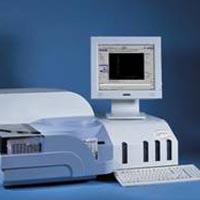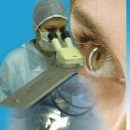Drug electrophoresis is a physiotherapy method that combines the action of a constant electric current and a medicinal substance. With this method of administration, drugs fall into the body through the skin and gland.
Content
The concept of drug electrophoresis
Medicinal electrophoresis (ionophoresis, iontophoresis) is a method of combined effect on the body of a constant electric current and a drug substance introduced with it. In this case, a significant role in the mechanism of action of drug electrophoresis is allocated as an active biological stimulus.
Distribution of medicinal substances in electrophoresis, compared with other ways to keep them, has a number of differences. The drug in this case penetrates the body through the skin, less often - through mucous membranes or wound surface. The occurrence of the drug when passing it through the skin are swelling of sweat and sebaceous glands, as well as intercellular gaps.
 During the electrophoresis of drugs, their deposit in the skin for the period from 1 to 2 days. From the skin depot due to osmosis and diffusion of motion, the drug substance slowly and gradually penetrates into deeper tissues, spreading with blood current throughout the body. In the future, the medicine is distributed in various organs. However, due to the action of the electric field, the greatest concentration of the drug is determined in the tissues lying in the interelectrode space.
During the electrophoresis of drugs, their deposit in the skin for the period from 1 to 2 days. From the skin depot due to osmosis and diffusion of motion, the drug substance slowly and gradually penetrates into deeper tissues, spreading with blood current throughout the body. In the future, the medicine is distributed in various organs. However, due to the action of the electric field, the greatest concentration of the drug is determined in the tissues lying in the interelectrode space.
Removal medication from the body is most often kidneys. Medicinal electrophoresis, in contrast to other treatment methods, has its own characteristics. During electrophoresis, the medicine is introduced in small quantities, which is usually calculated by milligrams or their shares. However, in this case, the drug turns out to be quite active to obtain a good healing effect.
Deposit medication in the skin during electrophoresis contributes to their long stay in the body, slow removal with urine and long-term action. As a rule, there are no adverse reactions inherent in drugs in the introduction of them in other ways, since their small quantities come to the body. In addition, the ballast part of the medication and solvent, often causing side effects, do not enter the body - they remain on the laying.
The method of drug electrophoresis makes it possible to introduce a pharmacological preparation directly to the lesion center, if the latter is located in surface tissues (leather, subcutaneous adipose tissue, mucous membranes). At the same time, drugs with circulating blood electrophores achieve deeply located tissues, concentrating in large numbers in organs in space between the electrodes.
Along with the advantages of this therapeutic method, some of its disadvantages should be noted. Not all medicinal substances can be used for electrophoresis. From a huge number of pharmacopy drugs for administration with electrophoresis, only limited quantity (about 200) is suitable. In the treatment of a number of diseases in which it is necessary to obtain a large concentration of medication in the body, the use of electrophoresis is inappropriate.
Variants of drug electrophoresis
In medicine, several varieties of electrophoresis were developed:
- Classic option
- Electrodengi
- Intra-band electrophoresis
- Intranate electrophoresis
- BioelectroCancenter therapy
Electrodengu - a special way of administering medicines by electrophoresis, which allows you to significantly reduce the procedure by saving medicines. This technique is applied in cases where expensive medicines are used for electrophoresis, for example, Caripzima or Caripain electrophoresis in diseases of the spine.
Internal electrophoresis - widely used in the treatment of diseases of the dental system, such as paradontosis, with diseases of the ear-throat and neurological diseases, for example, the introduction of electrophoresis by such drugs as cerebrolysis, relaignation. Special place is occupied by intra-high gynecological physiotherapeutic procedures, including intra-limited electrophoresis in the treatment of gynecological diseases.
Intranate electrophoresis - a type of electrophoresis when the medicine is accepted into or introduced by injection, the galvanization procedure is carried out in parallel. For example: in diseases of the joints in the acute period, especially in cases where physiotherapy procedures are contraindicated due to a strongly pronounced pain syndrome, the presence of an acute inflammatory reaction or synovitis (liquid in the joint cavity). In this case, the periarticular administration of drugs is carried out (the joint around is powered by a drug) according to a specific methodology and immediately after sheathing is carried out by galvanization procedure.
Bioelectrocentercer therapy or otherwise electrochemical lysis is designed to treat cancer by electroplating. The device for bioelectro-shirt therapy is fully computerized, selects the current parameters and controls the treatment process. The procedure of bioelectrocentercer therapy lasts 3 hours and is well tolerated by patients. This technique is shown for the treatment of cancer, both in the initial stages and in running, when the operational treatment is already contraindicated. This is a straw for which even those patients with cancer can be seized, which have almost made sentence.
Contraindications for the use of drug electrophoresis
Common contraindications for the purpose of physical factors:
- Individual intolerance to constant electric current
- Availability of artificial rhythm driver
- Insensitivity of the pharmacological preparation
- Gnove lesions of the skin on the places of imposition of electrodes
Advantages and disadvantages of medicinal electrophoresis
The advantages of the drug electrophoresis method are the creation of a skin depot, in which drugs are found from 1 to 3 days and more, exposure directly to the focus of inflammation, a significant demolition of side effects and allergic reactions, painless administration of medicinal substances.
The disadvantages of the method are not all drugs can be used for administration by electrophoresis, since their polarity and electrophoreticity are unknown; There is no possibility to create a large concentration of the drug substance; It is impossible to determine the exact concentration of the medicinal substance in the body.









